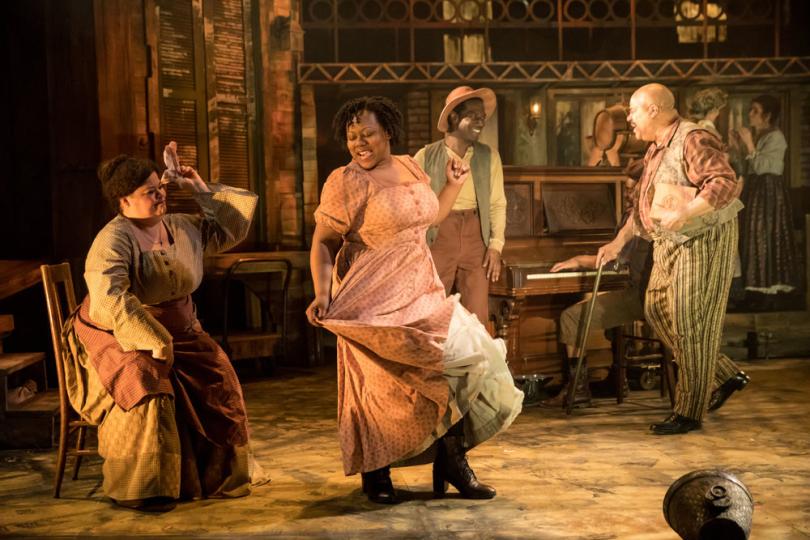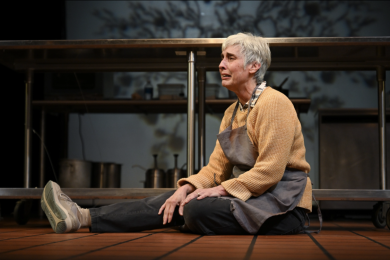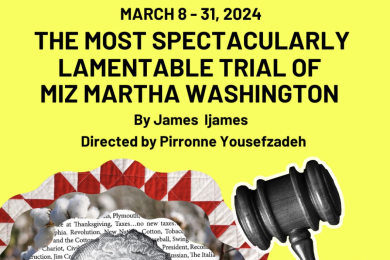Layered Voices and Communities

One of my favorite things about Theater Latté Da is their customary verve -- the world-premiere of Five Points (book by Harrison David Rivers, music by Etan D. Pakchar and Douglas Lyons) continues in this legacy. The cast is clearly enjoying themselves, and the audience is easily swept up in their contagious excitement.
Five Points relies on a bifurcated structure, with the main characters Willie Lane (Lamar Jefferson) and John Diamond (Ben Bakken) only really connecting near the end of the piece. Most of the time, we watch their two stories play out in different communities that are layered on top of one another in the famous New York City 5 Points confluence.
Pakchar and Lyons do a lovely job of continuing the play’s larger palimpsest motif in the music. Many songs are layered, with surprising musical juxtapositions that hint at disparate origins brought together. Unlike so many musicals which highlight only the leads and relegate the rest of the cast to ensemble work, Five Points provides musical vehicles for the whole talented cast. The upside is that the audience gets to hear everyone sing, and my goodness can they sing! The only potential downfall of this is that, with 13 songs in the first half and 10 in the second, there are so many barnburnering performances it is hard to remember exactly who the protagonists are supposed to be. This is, in my view, one of the ways that Five Points still feels a bit unresolved -- neither Willie nor John’s character arcs are entirely clear. John’s tragic backstory and family life are given more room than Willie’s family’s dance hall and his desire for fame, but neither really feels like a full-blown character. The actual climax of the of the piece (resulting in a dance-off between John and Willie in order to save something each holds dear), feels like an afterthought deep into Act 2. That doesn’t mean that the rest of the show is lacking in action, just that the string of songs and light dialogue don’t seem to move with much purpose towards the resolution.
Just as vital as another character, Joel Sass’s set and Mary Shabatura’s lighting design bring the city to life. Without many overt scene changes, the lighting scheme helps the city take on different aspects and moods -- sometimes lively and happy, sometimes desolate and dangerous. The lighting scheme emphasises the geometry and depth of the city. Strategic use of the partially exposed large back wall, as well as the clever lighting and positioning of an arcade of dirty windows, transports the audience all around the area. Playing with the same idea, many of the objects (such as the Almack's Dance Hall piano and McManus' bar) are two-faced Januses--they serve each community in a different way, further highlighting the cultural distance between them but also the dancing pastimes important to both.
For all that the lighting and scenic design cultivates the feeling of the city, the script itself is a bit mute on more of the social and political ramifications of the 5 Points area. This feels like a missed opportunity, because without its setting, this musical can feel very similar to others we have seen before (such as Ragtime). I missed a more detailed accounting of the similarities and differences between the Irish and Black communities, instead of simple representations of them. The fact that P.T. Barnum (Dieter Bierbrauer) goes after members of both groups points to their social and economic fragility, but this isn’t interrogated at length. Similarly, while there is talk of how dangerous 5 Points is and how hard it is for so many different communities to get along, we really only see the dangers once. In our current milieu, with so much anxiety surrounding immigration and pluralism, this feels like a missed opportunity to problematize our past. Instead of directly asking this question, we are given hopefulness for peaceful community embodied in John Diamond Junior (Alejandro Vega). He doesn’t seem to see race or creed, instead he looks for joy and community. His hybrid dancing, which incorporates the best of Willie and John’s techniques, points hopefully towards the future.
Whatever my qualms with the larger structure of the play, its production value is of the highest caliber. The talented cast is so large, it is hard to pick out the standout performances, but for me they would have to be Ann Michels’ Rona, whose amazing voice and characterizations breathe live into the conventional take-no-sass, hard-as-nails-but-matronly bar keeper. Her ballad is sweet and sad and has real pathos. Similarly, Willie and Cornelius King (John Jamison) “Whistle in the Wind” is beautiful the first time, and magical when Pauline King (Thomasina Petrus) and Stella Lane (T. Mychael Rambo) join in the reprise.
Newly-extended, my recommendation would be to go and see Five Points while you can! Support the work of Theater Latté Da and their amazing commitment to developing 20 new musicals in five years!




